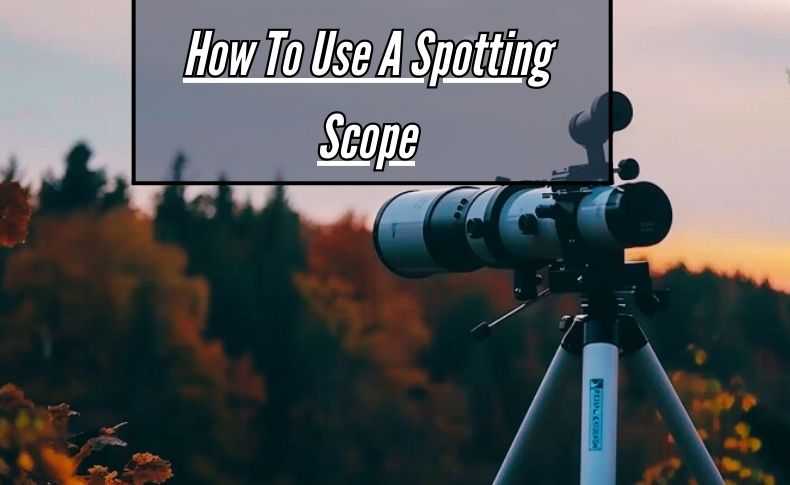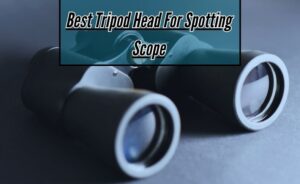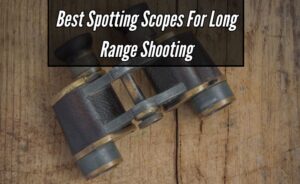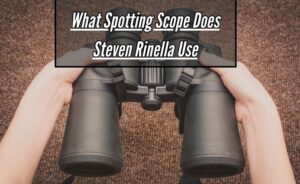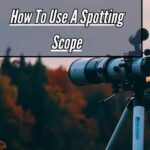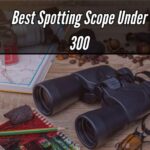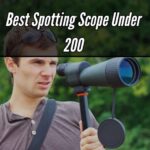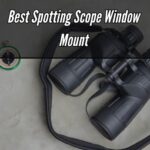Spotting scopes are very useful instruments for enlarging and making clearly visible objects that are far away. A spotting scope helps you see details that you might miss otherwise when studying celestial bodies, surveying landscapes, or monitoring wildlife. To operate a spotting scope efficiently, one must become proficient in the setup, focusing, and magnification adjustments processes.
How To Use A Spotting Scope? A sturdy tripod is the first step towards using an excellent spotting scope. For either stargazing or animal observation, adjust the focus and magnification to your preferred viewing conditions. Learn how to use the controls and take your time experimenting with various accessories, such as digi-scoping camera adapters.
In this guide, we’ll explore the basics of using a spotting scope, providing you with the knowledge and skills needed to make the most of this versatile optical instrument. Whether you’re a beginner or an experienced observer, learning how to use a spotting scope opens up a world of discovery and observation.
How To Use A Spotting Scope: From Setup to Sighting – A Comprehensive Guide
Embarking on a journey with your spotting scope opens a realm of possibilities, from observing wildlife to exploring the cosmos. This comprehensive guide will equip you with the knowledge to make the most of your spotting scope, covering everything from setup to sighting.
Setting Up Your Spotting Scope
Before you dive into the adventure, it’s crucial to set up your spotting scope correctly. Begin by mounting it securely on a tripod, ensuring stability for optimal viewing.
Adjust the tripod height to your comfort level, whether you’re birdwatching in a forest or stargazing under the night sky. Take your time to calibrate the focus and diopter adjustments for clear and crisp images.
Exploring Nature: Bird Watching and Whale Watching
One of the joys of using a spotting scope is observing nature’s beauty up close. Whether you’re birdwatching in your backyard or spotting whales along the coastline, your spotting scope enhances the experience by bringing distant subjects into clear view. Take note of the different behaviors and characteristics of birds or marine life as you explore their habitats.
Appreciating Scenic Vistas: Landscape Viewing
Venture beyond wildlife observation and immerse yourself in the breathtaking landscapes around you. Use your spotting scope to capture the intricate details of mountains, valleys, and other natural wonders.
Whether you’re hiking in the wilderness or enjoying a leisurely picnic, landscape viewing through your spotting scope adds a new dimension to your outdoor adventures.
Watching Ships and Surveillance
From the tranquil waters of a lake to the bustling activity of a harbor, watching ships through your spotting scope offers a glimpse into maritime life.
Additionally, your spotting scope can serve as a valuable tool for surveillance, allowing you to observe your surroundings with heightened clarity and precision.
Aiding Accuracy: Scoring Targets for Shooting and Archery
For sports enthusiasts, a spotting scope becomes an essential companion for scoring targets with accuracy. Whether you’re honing your skills in shooting or archery, your spotting scope provides valuable insights into your performance, helping you track and analyze your shots with precision.
Delving into the Cosmos: Stargazing and Digi-Scoping
As the sun sets and the night sky unfolds, your spotting scope transforms into a gateway to the cosmos. Explore the wonders of the universe as you gaze at distant stars, planets, and celestial phenomena.
For those inclined towards photography, digi-scoping allows you to capture stunning images of the night sky with your spotting scope and a compatible camera setup.
How To Use A Spotting Scope: Unlocking Precision by Mastering Its Features

Spotting Scope Selection: Finding Your Precision Tool
Selecting an appropriate spotting scope is essential to get accuracy in your observations. To make sure your scope suits your unique needs and tastes, take into account aspects like field of view, objective lens diameter, and magnification power.
Setting Up for Precision: Stability and Alignment
The right setup is the first step towards achieving precision with your spotting scope. Make sure your scope is precisely aligned with your target and firmly mounted on a sturdy tripod.
To get the best viewing and accurate aiming, take your time adjusting the height, location, and angle.
Precision in Focus: Calibrating for Clarity
Achieving clear and sharp views requires calibrating your spotting scope’s focus. Use the focus knob and diopter adjustment, among other features, to fine-tune your focus settings and get rid of distortion and blur.
Mastering Techniques for Precision Observation
Gaining proficiency in methods like tracking, panning, and scanning will improve your capacity to make accurate observations. To enhance your spotting abilities and make sure you don’t overlook any nuances in your observations, use these tactics on a daily basis.
Accessories for Precision Enhancement
With the appropriate adapters and extras, your spotting scope’s accuracy can be increased. Examine alternatives like tripod heads for accurate and seamless adjustments, smartphone adapters for digi-scoping, and ocular filters for glare reduction.
Capturing Precision: Digiscoping Techniques
Digiscoping offers a unique opportunity to capture precise images and videos through your spotting scope. Experiment with different camera settings and techniques to achieve the desired level of precision in your digiscoped creations.
How To Use A Spotting Scope: Eye Relief Demystified for Comfort and Visibility
Understanding Eye Relief: The Basics Explained
Acquire a basic understanding of eye relief before beginning your road towards mastery. Find out how the distance between your eye and the eyepiece impacts your visibility and comfort when using a spotting scope.
Optimizing Eye Relief for Comfortable Viewing
Optimize your spotting scope’s eye relief to uncover the keys to pleasant viewing. A comfortable viewing experience is ensured even during extended observation sessions by adjusting the eyecup or eyepiece position to the optimal distance between your eye and the eyepiece.
Maximizing Visibility: Enhancing Eye Relief for Clear Images
Optimize your spotting scope’s visibility and clarity by maximizing eye relief. Try a variety of eyepiece types and configurations to determine the best combination for minimizing eye strain and maximizing field of view for crisp, clear images.
Choosing the Right Eyepiece for Your Needs
For the best eye relief and the viewing experience you want, choosing the appropriate eyepiece is essential. When selecting an eyepiece that meets your needs and preferences, take into account variables like magnification, field of view, and eye relief distance.
Exploring Advanced Eye Relief Techniques
Explore sophisticated methods for adjusting eye relief to meet particular needs and viewing situations. Try adjusting the diopter, eyepiece extenders, and adjustable eyecups to get the best comfort and vision possible when setting up your spotting scope.
Navigating Eye Relief Challenges: Overcoming Obstacles
Overcome frequent obstacles related to eye relief, like wearing glasses and viewing in different light levels. Examine methods for getting around these challenges to guarantee a smooth and satisfying spotting scope viewing experience.
How To Use A Spotting Scope: Timing Is Everything for Maximizing Usage

Choosing the Right Time for Observation
Your spotting scope viewing experience can be much improved by choosing the best time to use it. To get the most clarity and visibility out of your observations, take into account variables like lighting, weather, and subject behavior.
Timing Your Setup for Stability and Comfort
For your observation sessions to be stable and comfortable, timing the spotting scope setup is essential. Prepare your scope well in advance so that you have time to fine-tune the tripod’s height, placement, and alignment for the best possible stability and comfort while watching.
Seizing Opportunities for Wildlife Observation
When it comes to using a spotting scope to observe wildlife, timing is everything. To increase the likelihood of obtaining crisp, in-depth sightings, practice patience and focus. Take advantage of opportunities to study and spot wildlife during their most active times, such as dawn and twilight.
Planning for Astronomical Observations
When arranging astronomical observations with your spotting scope, scheduling is crucial for both stargazers and astronomers.
Explore the night sky and take in breath-blowing vistas of stars, planets, and other celestial objects by taking advantage of clear evenings and favorable celestial events.
Utilizing Time-Lapse and Interval Shooting
Try time-lapse and interval shooting methods to see how versatile your spotting scope is. Capture dynamic sights and shifting landscapes throughout time to accurately record and clearly understand natural processes.
Timing Your Breaks for Eye Relief and Rest
It’s crucial to plan breaks for relaxation and eye relief in addition to the timing of your observation sessions.
To keep your focus and comfort levels high during your watching sessions, take regular breaks to rest your eyes, adjust the eyecups or position of your spotting scope, and replenish your energy.
How To Use A Spotting Scope: Sight Beyond Sight – Exploring the Hunting Advantage
Gaining a Strategic Advantage in the Field
With the ability to survey terrain, find game, and evaluate their environment from a distance, a spotting scope can give hunters a tactical advantage. Find out how utilizing a spotting scope may make your hunting more enjoyable and increase your chances of success in the field.
Spotting Scope Setup for Hunting Success
When it comes to making the most out of your spotting scope on hunting trips, proper setup is crucial. Optimize your hunting setup by learning how to use features like lens covers and sunshades, alter the focus and magnification settings, and mount your spotting scope on a sturdy tripod.
Scouting and Tracking Game with Precision
One of the most significant advantages of using a spotting scope for hunting is the ability to scout and track game with precision. Discover how to use your spotting scope to scan distant terrain, spot elusive prey, and track their movements for a successful hunting strategy.
Assessing Targets and Making Informed Decisions
Hunters can evaluate targets and make well-informed decisions prior to firing with the aid of a spotting scope. Gain knowledge about the size, age, and behavior of game animals using your spotting scope to ensure that you are hunting ethically and responsibly.
Navigating Challenging Terrain and Conditions
Hunting frequently occurs in difficult weather and topography, with occasionally poor vision. Consider how a spotting scope, which can provide crisp, detailed views of far-off objects even in poor light or with unfavorable weather, can assist hunters in navigating these challenges.
Utilizing Spotting Scope Accessories for Hunting
The usage of gear made especially for spotting scope use will improve your hunting experience. See how you can enhance your hunting setup and increase the functionality of your spotting scope in the field with accessories like tripod mounts, carrying cases, and digi-scoping adapters.
How To Use A Spotting Scope: Through the Lens – Expert Tips for Digiscoping

Exploring the world of digiscoping allows you to use your spotting scope to take breathtaking pictures in new and exciting ways. We’ll go over professional advice and methods in this article to help you make the most of your gear, from tripod setup to photo editing and sharing.
Setting the Scope up on the Tripod
Before delving into the world of digiscoping, it’s essential to set up your spotting scope securely on a tripod. Position the tripod on stable ground, adjusting the height to your preference for comfortable viewing. Ensure that the mounting plate securely holds your spotting scope in place, minimizing vibrations for clear and steady images.
How to Tilt & Pan the Scope
Mastering the art of tilting and panning your spotting scope is key to capturing the perfect shot through your camera. Adjust the tilt and pan controls on your tripod to smoothly track moving subjects or explore different angles.
Take your time to familiarize yourself with these adjustments, allowing for precise framing and composition in your photos or videos.
Preparing the Scope for Use
Before attaching your camera for digiscoping, it’s important to prepare your spotting scope for optimal performance. Calibrate the focus and diopter adjustments to ensure clear and crisp images through the scope’s eyepiece.
Take note of any environmental factors such as lighting conditions or weather that may affect your digiscoping experience.
Camera Adapters for Spotting Scopes
Purchasing a high-quality camera adapter is necessary if you want to use your spotting scope for digiscoping. To ensure a safe and reliable connection, select an adapter that is compatible with the model of your camera and spotting scope. Try out various adapter choices to determine which one best fits your digiscoping requirements and preferences.
Exploring Advanced Techniques
Beyond traditional photography, a universe of creative possibilities is available with dissenting. To get the results you want in your digiscoped photos, play about with the camera’s exposure and aperture settings.
To improve your digiscoping experience and produce amazing images and films, experiment with different attachments like remote shutter releases or filters.
Editing and Sharing Your Digiscoped Images
Once you’ve captured your digiscoped images, take the time to edit and enhance them using photo editing software. Adjust the brightness, contrast, and saturation to bring out the details and colors in your photos.
Share your digiscoped creations with fellow enthusiasts on social media platforms or online forums to inspire and connect with others passionate about digiscoping.
Conclusion
In conclusion, becoming proficient with a spotting scope unlocks a world of exploration and learning. You can precisely and clearly see the beauty of nature if you have the necessary knowledge and skills.
Whether you’re hunting, birdwatching, or just taking in the night sky, a spotting scope lets you observe the world around you in a whole new way. Take your time, become acquainted with your spotting scope, try out various settings, and go on a plethora of amazing and thrilling experiences.
Frequently Asked Questions (How To Use A Spotting Scope)
What is the best way to use a spotting scope?
There are a few essential procedures to efficiently using a spotting scope. To reduce shakiness, you should first mount your spotting telescope on a sturdy base, such as a tripod. Next, concentrate on your target by adjusting the eyepiece and objective lens. To acquire a clear image, start with a low magnification and then progressively increase it.
To avoid eye strain and preserve your sense of depth, keep both eyes open. Use the scope’s fine-tuning controls to further sharpen the image once you’ve located your target. To reduce vibrations, be patient and breathe steadily. Finally, if you’re sharing the view with others, make sure they can easily observe via the scope by describing where to gaze. Precision and steadiness are essential while using a spotting scope.
How do I choose the right spotting scope for my needs?
It’s important to select the best spotting scope for your needs. Think about things like durability, magnification, and the size of the objective lens. Choose a scope with a 20–60x amplification for bird watching or wildlife observation, and go for a larger objective lens for better photos. Select a greater magnification, such as 20–60x, if you enjoy target shooting for improved accuracy.
For use outside, look for scopes with characteristics like fog- and waterproof-proofing. Furthermore, travel-friendly scopes that are small and light are ideal. To guarantee quality, read reviews and get suggestions. To choose the finest option, ultimately match the qualities of the scope with your unique activity.
What’s the significance of magnification and objective lens size?
The size of the objective lens and magnification play a major role in a microscope’s power and clarity. The degree that an item looks larger than it is to the unaided eye is known as magnification, and the size of the objective lens affects how much light is captured to produce sharper images. Larger objective lenses improve brightness and resolution, while higher amplification permits in-depth examination of minute structures.
Achieving the ideal equilibrium is essential to successful microscopy. Recall that for best image quality, the right objective lens size should be used in conjunction with increased amplification—more magnification isn’t necessarily better. A better knowledge of microscopic features in a range of samples is ensured by adjusting both elements.
What accessories enhance spotting scope functionality?
You can get much more out of your spotting scope experience with accessories. A strong tripod minimizes shakiness and offers stability for crisp viewing. To keep your scope safe while being transported, get a high-quality carrying case. Lens covers ensure lifetime by providing protection from dust and scratches.
With the help of eyepiece adapters, attaching a smartphone or camera is simple and allows you to take amazing pictures. A sunshade might help reduce glare and preserve the best possible image quality. Finally, lens cleaning kits are necessary to keep your optics clear. Your outdoor experiences will be more joyful with these accessories, which not only prolong the life of your spotting scope but also improve its functioning.
How do I maintain and clean my spotting scope?
First, clean the lens of your spotting scope by using compressed air or a soft brush to remove any dust or debris. Using a microfiber cloth, gently wipe the lens, going from the center to the edges in a circular motion. If the stain is very difficult to remove, moisten the fabric with a solution of water and a light detergent.
Do not use strong chemicals. When not in use, place the scope in a protective case to shield it from dings and scratches. Don’t forget to keep it somewhere dry and cold. Check for wear and loose parts on a regular basis. You can make sure your spotting scope remains clean and operates at its best for many years by following these easy procedures.
Can I use a spotting scope for digiscoping?
Yes, digiscoping can be done with a spotting scope. Digiscoping is the process of using a smartphone or digital camera attached to a spotting scope in order to take pictures from a distance. Make that the digiscoping eyepiece or the required adapters are attached to your spotting telescope. Set the focus on both devices by lining up the camera lens with the eyepiece of the scope.
For sharper photos, vibrations can be minimized by using a timer or remote shutter. To get the best outcomes, try out several configurations. Digiscoping is a terrific way to use your smartphone or camera to conveniently capture far-off vistas or enjoy birding.

